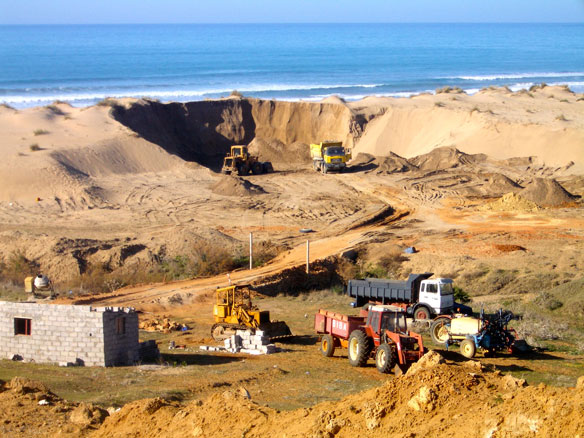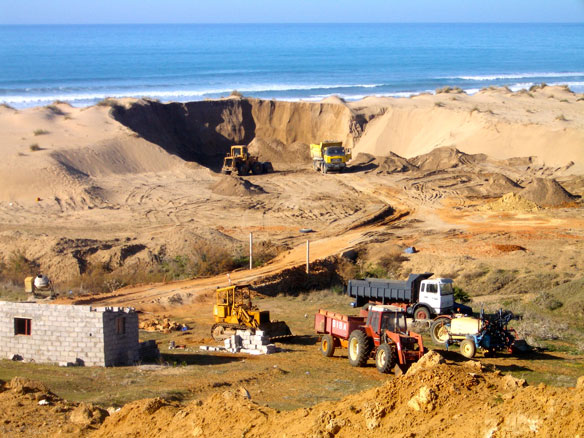
Illegal beach sand mining, Moroccan coast. Photograph: © SAF
By Kiran Pereira
Water does not exist in isolation. It is an integral part of any ecosystem and as such, every major change to this ecosystem has hydrological impacts which then lead to sociological, economic and other environmental consequences. The world’s freshwater resources are under threat from a wide variety of factors. Many of them such as over-abstraction of water from rivers and aquifers, pollution from point and non-point sources, changing patterns of precipitation are popularly known, debated and discussed widely. However, there are other crucial factors with significant social, environmental and economic impacts that are less known. One such threat is an activity known as ‘sand mining’ also referred to as dredging or gravel mining.
… Contrary to literature that says sand mining is not as environmentally damaging as other kinds of mining, it may be even more so because of its insidious nature and the fact that its effects often take decades to surface.
—Kiran Pereira
Sand mining has several negative impacts.
It poses a threat to water security in several ways. Dredging results in lowering of the alluvial water table which, in turn, directly affects groundwater storage capacity (See Kondolf et al., 2001). Excessive dredging allows for saline intrusion into groundwater (Viswanathan, 2002). The lowered water table implies a rise in water costs, thus restricting access to only those who can afford it (Hoering, 2008). It results in habitat loss including destruction and fragmentation of fragile, endangered ecosystems and reduced species richness (See Myers, 1999, Global Witness, 2010).
Sand mining also causes increased shoreline erosion rates, especially when mined unscientifically (Byrnes et al., 2000) and decreases protection from sea water especially during ocean disasters (Myers, 1999). It also poses a threat to critical infrastructure such as bridges, roads, railway tracks (Kondolf et al., 2001). Sand mining has also been known to cause loss of livelihoods in several instances (See Hoering, 2008, Young and Griffith, 2009 and Viswanathan, 2002). Other macroeconomic impacts have also been observed such as changes in land use patterns (Myers 1999) and increased public health costs (Myers & Muhajir I997, Mensah, 1997).
The demand for sand is fuelled by numerous factors. It appears that sand has long been commoditized and is now entrenched in global trade. Table 1 below illustrates the high trade value of this commodity. Despite the high value of this trade, or perhaps because of it, the activity is surprisingly depoliticized except when there are public concerns in specific areas.
Table 1: Global Trade in Stone, Sand and Gravel
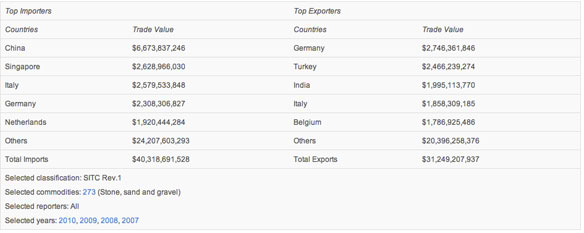
Compiled from UN Comtrade, United Nations Commodity Trade Statistics Database
It is no surprise that sand is indispensable for many economic development activities such as road building and concrete production. It also has other familiar uses such as in glass-making for window panes, glassware, glazing for pottery, lenses, television tubes, mirrors, fibreglass reinforcement, lamps, stained glass art, lasers, insulators, telescopes, bottles and containers for alcohol, soft drinks, and food items like jams, pickles (USGS, 2011). However, it is also used in several concealed ways such as hydraulic fracturing applications (Scienceviews.com, 2003-2010), in the making of semi-conductors that are used in almost every electronic device today ranging from notebooks to mobile phones and even in cars. Sand is also a source for strategic minerals such as Silica, Garnets, Thorium and ores such as Titanium, Uranium, Zirconium, Ilmenite which are in turn used in applications too numerous to list here. Nonetheless, two examples can be given to illustrate the breadth of use:
a) Titanium is used in ‘Production of lightweight alloys, aircraft components (jet engines, aircraft frames), automotive components, joint replacement (hips ball and sockets), paints, watches, chemical processing equipment, marine equipment (rigging and other parts exposed to sea water), pulp and paper processing equipment, pipes and jewellery [sic]’ (IIED and WBCSD, 2002).
b) Heavy Minerals such as Rutile, Sillimanite and Monazite are also sourced from sand. They find use in in the paint industry, welding electrodes, ceramics, foundry and also various applications like plastics, sun screen, food colouring and biomedical applications (Corpwatch, 2007). The most astounding use in terms of volume however, is the creation of ‘new land’. For e.g. Around 500 million m3 of sand was reclaimed (from the ocean bed) for the Palm Island II (Jebel Ali) and Waterfront projects on the coast of Dubai. ‘This equates to a row of trucks encircling the Earth about 22 times’ (Jan De Nul Group, 2009).
Given this demand situation, let us explore the supply side of the equation which exhibits a great spatial and temporal mismatch.
Although sand is more than abundantly available in deserts, this sand is not popularly considered a ‘resource’ because the physical morphology of such sand is not considered suitable for construction and other industrial activities. For such uses, ‘good quality’ sand is sourced primarily from relatively limited sources. Marine and terrestrial deposits are the two main sources. Marine (offshore) and terrestrial deposits are the two main sources. Offshore dredging is far more expensive, requires specialized equipment and special environmental permits. Offshore dredging is far more expensive, requires specialized equipment and special environmental permits. It is consequently used mostly by developed economies such as the US and Europe. As for terrestrial sources, river channel deposits, residual soil deposits and floodplain alluvial deposits are the most usual ones (Gelabert, 1997 in Cambers, 1997). Although continuous excavation can deplete sources in decades, some sands are said to be laid down from around 115 million years ago (The Greensand Trust, 2010). With a rapidly urbanizing world, such a perpetual demand vis-à-vis a limited supply of an easily available resource such as sand creates a rather complex situation with many winners and losers. Problems associated with sand mining have been reported across many regions of the world (Young and Griffith, 2009).
… Although continuous excavation can deplete sources in decades, some sands are said to be laid down from around 115 million years ago.
—Kiran Pereira
Some examples include Australia (Ratcliffe, 1997; Stoltz, 2011), Cambodia (Global Witness, 2010), Ghana (Mensah, 1997), India (Hoering, 2008; Padmalal et al., 2008; Sekhar and Jayadev, 2003; Sreeba and Padmalal, 2011), Namibia (Hartman, 2010), Tanzania (Nyandwi, 2001), United States (Brynes et al., 2000; Brynes et al.,2004; Femmer,2002; Kondolf et al., 2001), Bolivia, Brazil, Paraguay, Argentina, and Uruguay (Halweil, 2000), Bosnia (Clancy, 2004). Island states in particular feel the acute tension between ‘development’ and the need to protect the coast. Numerous examples can be found in many of the Caribbean Islands such as Puerto Rico, Grenada, Tobago, Montesserat, British Virgin island and others (Cambers, 1997), Jamaica (Farrant et al., 2003), Sri Lanka (Gunaratne and Jayarooriya, n.d.), Indonesia (Kamis, 2011, The Jakarta Post, 2007) and Maldives (PTI, 2008, Jacob, 2010).
In terms of sheer volume, aggregates of construction minerals (such as sand and gravel) account for the largest material volumes mined in the world where the global production in 2000, was estimated to exceed 15 billion tonnes per year (IIED and WBCSD, 2002). The irony of this situation is that despite being extracted at such gargantuan rates, sand is classified as a ‘low value’ resource (Ibid) and also a ‘minor’ mineral resource even in legislation in many countries such as India (See MAC, 2007).
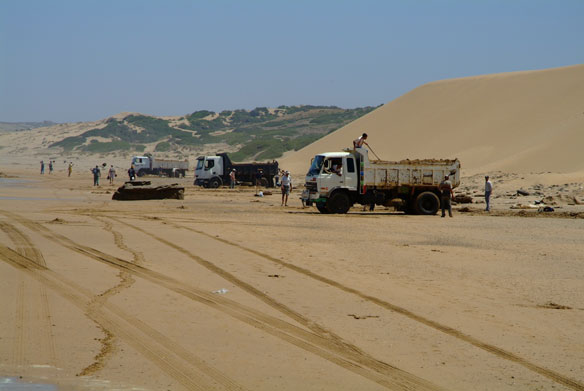
Illegal beach sand mining, Moroccan coast. Photograph: © SAF
There is also literature that explicitly states that sand mining is not as environmentally destructive as other kinds of mining. For e.g. The United States Geological Survey (2011) states ‘Except for temporarily disturbing the immediate area while mining operations are active, sand and gravel mining usually has limited environmental impact.’ This paradigm is only a partial truth and needs to change because it robs science and politics of the incentive to explore alternatives.
… In terms of sheer volume, aggregates of construction minerals (such as sand and gravel) account for the largest material volumes mined in the world.
—Kiran Pereira
The author researched this topic further through a case study based in India. Three villages Mahad, Toradi and Bankot were selected. These villages lie along the Western Ghats of India, a region that is one of the world’s ten ‘hottest biodiversity hotspots’, with at least 325 globally threatened species occurring there (Myers et al.,2000). The region is also a very important watershed region for India. Rampant sand mining, often illegal, with high degree of political involvement, has wreaked havoc in the area. In the current scheme of things, neither the environment nor the local people seem to have voice in the matter. Dredging in the area has been going on for the last 20 years and was initially welcomed because it brought a new form of employment. However, with mechanical dredging, several problems have surfaced over the last 10 years and locals have been demanding a stop to this activity. Locals and the NGO working with them have each used the Right to Information Act (RTI) to obtain reports of resolutions of various gram panchayats (local governments) that confirm this popular protest. Yet, sand mining continues unabated and most of the dredged sand is sent to Mumbai, the financial capital of India.
Several ill-effects were noted in the region and they far outweighed the positive impacts on the region. The negative impacts of sand mining in the region are given below:
As per law, no dredging was allowed during the night, but in reality it was said to continue non-stop over 24 hours, every day of the year. The constant noise of mechanised dredging all day and all night was a major inconvenience to the residents because it also hampered sleep and the functioning of primary and secondary schools in the area.
Several landslides with much casualty have been reported in the region and official reports attribute it to heavy rains. However, locals believe sand mining to be the root cause. As one person said, ‘It is like this, if you make a heap of grain and you will remove grains from the bottom, the grain at the top will naturally fall. The base of the mountain is in the river. When you remove sand from the river, what else will happen?’
Both Mahad and Toradi faced similar challenges in that they were located downstream from an industrial estate run by the Maharashtra Industrial Development Corporation (MIDC) which was said to discharge untreated and hazardous industrial effluents into the river, leading to massive fish kills. It also made the water unfit for agriculture.
The deep dredging had worsened the problem. Locals claimed that ancient wells had begun to run dry because of falling water tables. Removal of the sand had also removed the last barrier to the leaching chemicals dumped in the river (as mentioned above), thus allowing the chemicals to seep further inland making groundwater unfit for domestic consumption. A report on water quality by the government Primary Health Centre confirmed the worst suspicions of the locals with ‘4 hoi and 38 nahi’ (4 yes and 38 nos) on various parameters.
Fishing was also affected because it was seasonal and fishermen could not fish during monsoons. They did not have an alternate means of livelihood, especially during the off-season. Therefore, the rest of the 8 months of work completely determined their quality of life. One person said, ‘In the past, 5 people depended on one boat but today one boat can support only 1-2 people – can’t give wages. It is difficult to maintain families’. Another said, ‘No bank is willing to give us a loan. We need to educate our children but we can’t afford it.’
Sand barges often damaged fishing nets and reduced their catch. There had also been occasions of collision with fishing boats but ‘no one was willing to register complaints.’ They spoke of barges shifting sand and clay which resulted not only in nets going under soil because of disturbance but also disturbed navigational channels which then hampered local fishing operations especially during low tide.
The constant noise and disturbance of breeding grounds was also changing the kind of fish that can survive in the river. Consequently, the high-value catch for the local fishermen has diminished. They also felt their life was ‘under pressure’ and they were constantly ‘afraid of being dashed by the barges’. Official statistics too confirm this trend of declining fish stocks, though they do not attribute it to sand mining. See Table 2 below.
Table 2: Estimated Annual Marine Fish Production – Raigad and Ratnagiri
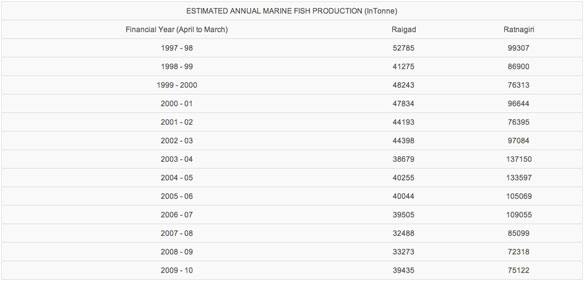
Source: Department of Fisheries, Government of Maharashtra (India) (Compiled from Fish Production Reports across the years).
Given the rapid rate of urbanization and the current rate of extraction of sand and the silent devastation left behind in its wake, the modern process of assigning value, economic or otherwise to resources seems sadly inchoate and needs to be re-evaluated. In matters of food, clothing and other activities, we are influenced in many ways by the physical setting in which we live – coastal, desert, mountainous or forest regions. But we are also proficient at changing the environment ‘with unprecedented speed and effect’ (National Academy of Sciences, 1969, p26).
… Despite the high value of this trade, or perhaps because of it, the activity is surprisingly depoliticized except when there are public concerns in specific areas.
—Kiran Pereira
With globalization, there is a tendency for infrastructure, especially urban ones to be similar across geographies (ibid). Roads, bridges, airport runways are soon becoming ubiquitous. Availability of sand or the lack thereof thus directly or indirectly affects all who partake in this cup of modernity. The immediate effects of the lack though are felt most by the local community. Contrary to literature that says sand mining is not as environmentally damaging as other kinds of mining, it may be even more so because of its insidious nature and the fact that its effects often take decades to surface. Mining for iron ore or bauxite may cause alteration of the landscape so violently that its ill-effects are impinged on the viewer’s consciousness instantly whereas the gradual transformation of sand into bridges, roads, houses, paints, glassware, and other things that are taken for granted in modern urban lives is almost imperceptible. To the non-local spectator, nothing seems to be lost in the process beyond the inconvenient depletion of sand and the creation of visible craters in some instances. Sand mining has an undeniable impact on water resources and the people dependent on them, especially when carried out in an unscientific manner.
The paradox of this ‘high volume – low value’ resource needs to be explored further, particularly by those in academia and policy circles.

Photo source: ©© Nwardez
About the Author: Kiran Pereira
Kiran Pereira would like to describe herself as a water warrior of sorts. She recently completed an MSc Environment and Development at King’s College, London. Her dissertation was titled ‘Sand: A Scarce ‘Symbol of Abundance’? Tracing the Contested Mindscape around Sand Mining‘. She has experience in capacity building, CSR, writing sustainability reports and the like. She worked for 10 years in the corporate sector before embarking on a master’s programme.
Article Originally published by: AquaKnow
References:
Byrnes, M. R., Hammer, R M. , Thibaut, T.D., Snyder, D.B. (2004) ‘Effects of Sand Mining on Physical Processes and Biological Communities Offshore New Jersey, U.S.A.’, Journal of Coastal Research 20(1), 25–43.
Byrnes, M.R., J.S. Ramsey, R.M. Hammer, and E.A. Wadman (2000) ‘Assessing Potential Environmental Impacts of Offshore Sand and Gravel Mining’. Final Report to the Commonwealth of Massachusetts, Executive Office of Environmental Affairs, Coastal Zone Management, 43 pp.
Cambers, G. (ed.), 1997 ‘Managing Beach Resources in the Smaller Caribbean Islands’ Papers presented at a UNESCO – University of Puerto Rico Workshop, 21- 25 October 1996, Mayaguez, Peurto Rico. Coastal region and small island papers, No.1, UPR/SGCP-UNESCO, Mayaguez,269 pp.
Clancy, T. (2004) ‘The War on Bosnia’, World Watch Magazine [Online] Available: World Watch (accessed 31 July 2011).
Corpwatch (2007) ‘Titanium or Water? Trouble brews in Southern India’; Available: Corp Watch(Accessed 3rd Aug, 2011).
Department of Fisheries, Government of Maharashtra (India) n.d.; Available: Fisheries Maharashtra (accessed 18 August 2011).
Farrant, A. R., Mathers, S. J. and Harrison, D. J. (2003). ‘River Mining: sand and gravel resources of the lower Rio Minho nad Yallahs fan-delta, Jamaica’, British Geological Survey Commissioned Report CR/03/161N. 24pp
Femmer, S. R. (2002) ‘Instream Gravel Mining and Related Issues in Southern Missouri’ USGS Fact Sheet 012–02, US Department of Interior.
Gelabert, P.A. (1997) ‘Environmental Effects of Sand Extraction Practices in Peurto Rico’, Cambers, G. (ed.), 1997 ‘Managing Beach Resources in the Smaller Caribbean Islands’ Papers presented at a UNESCO – University of Puerto Rico Workshop, 21- 25 October 1996, Mayaguez, Peurto Rico. Coastal region and small island papers, No.1, UPR/SGCP-UNESCO, Mayaguez, 269 pp.
Global Witness (2010) ‘Shifting Sand – How Singapore’s demand for Cambodian sand threatens ecosystems and undermines good governance’; Available:Global Witness (accessed 31 July 2011).
Gunaratne and Jayarooriya, n.d. Gunaratne, L.H.P. and Jayarooriya,K.A.S.P (n.d.), ‘River sand mining in Sri Lanka: trade-off between private profitability and environmental costs’, Department of Agricultural Economics and Business Management, University of Peradeniya, Peradeniya ,Sri Lanka; Available: Department of Agricultural Economics and Business Management, University of Peradeniya (Accessed 3rd Aug,2011).
Halweil, B. (2000) ‘Where have all the farmers gone?’, World Watch Magazine Volume 13, No.5; Available: World Watch(accessed 31 July 2011).
Hartman, A. (2010) ‘Namibia: Uncontrolled Sand Mining Days Numbered’ , All Africa.com; Available: All Africa (accessed 31 July 2011).
Hoering, U. (2008) ‘Water to the People – Drinking Water and Water for Livelihoods’, Conflicts and Alternative Concepts in India, EED Church Development Service, Germany and Water and Democracy Initiative, India; Available: Eed (Accessed 15thAug, 2011).
IIED and WBCSD (2002) ‘The Report of the Mining, Minerals and Sustainable Development Project’, Earthscan; Available: Wbcsd (Accessed 3rd Aug, 2011).
Jacob, S. (2010) ‘Bangladesh sand to help keep Maldives afloat’, Business Standard; Available: Business Standard India (accessed 31 July 2011).
Jan De Nul Group (2009) ‘Reclamation Dredging’; Available: Jan de Nul (Look under the following tabs: Activities>Dredging and Marine Works>Reclamation Dredging) (accessed 1 August 2011).
Kamis (2011) ‘People of Wera Resist Iron Sand Mining Corporations’ , Hidup Biasa; Available: Hidubiasa(accessed 31 July 2011).
Kondolf, G.M., Smeltzer, M., Kimball, L. (2001) ‘Freshwater Gravel Mining and Dredging Issues’, Whitepaper prepared for Washington Department of Fish and Wildlife, Center for Environmental Design Research, University of California, Berkeley, Available: Wdfw (Accessed 3rd Aug, 2011).
MAC: Mines and Communities (2007) ‘Dark Side of Mining’; Available: Mines And Communities (accessed 20 August 2011).
Mensah, J. V. (1997) ‘Causes and Effects of Coastal Sand Mining in Ghana’, Centre for Development Studies, University of Cape Coast, Ghana, Singapore journal of Tropical Geography, 18(1), 1997. 69 – 88.
Myers, G. & M. Muhajir. (I997) ‘Localizing agenda 2 i: environmental sustainability and Zanzibari urbanization’, ‘Third World Planning Review’ I9: 367-84.
Myers, N., R.A. Mittermeier, C.G. Mittermeier, G.A.B. Da Fonseca, and J. Kent. (2000) “Biodiversity Hotspots for Conservation Priorities.” Nature 403:853–858.
National Academy of Sciences (1969) ‘Resources and Man’, Committee on Resources and Man, National Research Council, W.H. Freeman and Company, United States of America.
Nyandwi, N (2001) ‘Survey of the Extent of Human-induced beach erosion problems in Tanzania’ Institute of Marine Sciences, University of Dar es Salaam Tanzania.
Padmalal, D., Maya, K., Sreeba, S., Sreeja, R. (2008) ‘Environmental effects of river sand mining: a case from the river catchments of Vembanad lake, Southwest coast of India’ Environ Geol (2008) 54:879–889, Springer.
PTI (2008) ‘India raises limit on export of river sand, stone to Maldives’ , The Economic Times; Available: The Economic Times of India (accessed 31 July 2011).
Ratcliffe, R. (1997) ‘Opposition to sand mining on Stradbroke’, Green Left; Available : Green Left (accessed 31 July 2011).
Scienceviews.com (2003-2010) ‘Sand and Gravel’; Available: Science News Geology (Accessed 3rd Aug, 2011).
See Myers, 1999, Myers, G. (1999) ‘Political Ecology and Urbanisation: Zanzibar’s Construction Materials Industry’, ‘The Journal of Modern African Studies’, Vol. 37, No. 1 (Mar., 1999), pp. 83-108.
Sekhar, L. K. and Jayadev, S. K. (2003) ‘Karimanal (Mineral Beach-Sand) Mining in the Alapuzha Coast of Kerala – A People’s Perspective’, in Martin J. Bunch, V. Madha Suresh and T. Vasantha Kumaran, eds.,Proceedings of the Third International Conference on Environment and Health, Chennai, India,15-17 December, 2003. Chennai: Department of Geography, University of Madras and Faculty of Environmental Studies, York University. Pages 470 – 488.
Sreeba,S. and Padmalal, D. (2011) ‘Environmental Impact Assessment of Sand Mining from the small Catchment Rivers in the Southwestern Coast of India: A Case Study’ Environmental Management 47:130–140.
Stoltz, G. (2011) ‘Police to Probe Sand ‘Theft’, Courier Mail; Available: Worker Bush Telegraph (accessed 31 July 2011).
The Greensand Trust (2010) ‘Geology, The Virtual Sand Museum’; Available: The Sand Museum (accessed 3 August 2011).
The Jakarta Post (2007) ‘Govt Told Not to Resume S’pore Sand Exports’; Available: Mines and Communities (accessed 31 July 2011).
UN Comtrade , United Nations Commodity Trade Statistics Database; Available: UN Comtrade (accessed 3 August 2011).
USGS, U.S. Geological Survey (2011) ‘Sand and gravel (industrial)’, Silica Statistics and Information; Available: USGS (accessed 3 August 2011).
Viswanathan, S. (2002) ‘Mining Dangers’, Frontline Vol 19 – Issue 10; Available: Frontline (accessed 3 August 2011).
Young, R. and Griffith, A. (2009) ‘Documenting the global impacts of beach sand mining’, European Geosciences Union, General Assembly; Available: Coastal Care (Accessed 3rd Aug, 2011).

